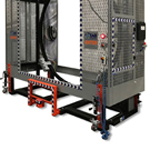Whether you’ve outgrown your current stretch wrapper or are considering one for the first time, it’s important to weigh your options carefully to find the best fit for your needs and budget.
1. How many loads do you wrap per day?
To get the most benefit from any stretch wrapping machine, you’ll need to be sure it is rated to handle the number of loads you plan to stretch wrap each day. Some turntable stretch wrappers can only handle 20 loads per day and will quickly wear out if you push them beyond their recommended capacity.
It’s best to buy a more robust stretch wrapper than you think you might need, to give your shipping operation room to grow. For example, if you currently wrap and ship 20 loads per day, opting for a machine that can handle double that capacity is a solid investment.
Also keep in mind that many stretch wrappers with added capacity may also provide additional features such as a ramp or built-in scale.
2. Do you handle irregularly shaped loads?
Most stretch wrappers have a difficult time wrapping irregularly shaped loads. These might include items that need to be placed on longer pallets, forged metals, oddly shaped fabricated parts and more.
The reason these items are so difficult to wrap is that they don’t conform to the same dimensions as a typical pallet. Turntable or straddle stretch wrappers wrap the load around the perimeter of the pallet, so there’s no way to secure oddly shaped items. It can also be difficult to stretch wrap objects that are short and flat.
If you plan to stretch wrap any of these items and don’t want to handle the task by hand, consider an orbital stretch wrapper that wraps the load from top to bottom, securing elongated, short, flat or oddly shaped loads with ease.
3. Are your products typically very light or very heavy?
Consider the typical weight of the products you ship. Are many of them either very light or very heavy?
The most common type of stretch wrapper uses a turntable that turns the pallet during the wrapping operation. Turntable stretch wrappers aren’t typically a good choice for very light items, since the turning motion (typically 12 to 15 rpm) causes light loads to fall off the pallet.
A straddle stretch wrap machine that keeps the pallet stationary and applies the stretch wrap with a moving arm may be a better choice if you ship many light loads.
A turntable stretch wrapper is also a poor choice for loads that exceed 5000 lb., unless the machine is rated to handle the extra weight. Straddle style stretch wrappers and orbital wrappers are better suited to handle heavy loads. Be sure to check the weight capacity of any stretch wrapper you’re considering, if you typically ship large or heavy items.
4. Should you invest in automation?
Typically, stretch wrappers come in one of two types – semi-automatic and full-automation.

Most semi-automatic stretch wrappers require human intervention to begin the wrapping process. This means that a worker must first place the pallet on the turntable, and then manually configure the stretch wrap to begin the wrapping operation. Some models also require cutting the stretch wrap when wrapping is complete.
On the other hand, a stretch wrapper with full-automation requires much less human intervention. Usually, the worker does not need to exit the forklift and can activate the wrapping process with a remote switch. The only time it’s necessary to handle the stretch wrapper is when the stretch wrap breaks or needs to be refilled.
So which should you choose?
That’s going to depend on your needs and budget. Semi-automatic units are typically less expensive, but you need to weigh that cost savings against the extra time and effort your workers will expend getting the machine setup for each load.
For example, if you stretch wrap 400 loads per week, it will take an average of 20 hours with a semi-automatic stretch wrapper. You’ll likely complete the same number of loads in just 10 hours with a full-automation model, a labor of savings of 50%.
5. Will you need to move your stretch wrapper?
Consider any mobility requirements you have for your stretch wrapper. Will you need to move it from one section of the warehouse to another or do you have a dedicated area where it is likely to stay?
Both turntable and orbital stretch wrappers can be moved quite easily from one place to another and either are a great choice if you require frequent mobility.
While straddle stretch wrappers offer many advantages to a shipping operation, they are stationary by nature, making them very difficult to move. Straddle stretch wrappers need to be bolted in place to function properly.
As you can see, there are many factors to consider when choosing the right stretch wrapping machine for your shipping operation. To make sure your new machine is an asset you’ll appreciate for years to come, carefully consider the number of loads you wrap each day, as well as the types of loads you’ll need to wrap. Then factor in your needs for automation and portability to find a machine that offers the best balance of function and versatility.

